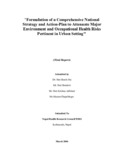Please use this identifier to cite or link to this item:
https://hdl.handle.net/20.500.14356/340| Title: | "Formulation of a Comprehensive National Strategy and Action-Plan to Attenuate Major Environment and Occupational Health Risks Pertinent in Urban Setting" |
| Authors: | Nepal Health Research Council (NHRC) Jha, Hari Bansh, Dr. Barakoti, Hari Adhikari, Hari Krishna Magar, ShyamuThapa |
| Issue Date: | 2006 |
| Publisher: | Nepal Health Research Council |
| Keywords: | National Strategy and Action-Plan Occupational Health Risks Environment |
| Abstract: | Executive Summary: In Nepal, the planners and policy makers started realizing the importance of environmental and occupational health risk issues basically from the Sixth Plan (1980-85). However, there is no sign of any meaningful change in environmental and occupational health risks in the urban areas. This is also due to the fact that major environmental and occupational health risk factors had not been identified in the country and there was also a lack of strategic action plan to address such issues. Hence, the present study was carried out to: (a) Identify the major environmental and occupational health risk factors in urban settings; (b) Prepare strategic action-plan to attenuate public health risks caused by major environmental and occupational health and safety situations within the urban settings; and (c) Disseminate the prepared strategic action plan by organizing a dissemination workshop. To achieve the above objectives, both the secondary and primary source materials were used for data collection. The secondary source information was collected from various publications of government and non-governmental agencies, international organizations and different other sources. Similarly, the primary source data were collected partly by interviewing the key resource persons and partly through observations made on the state of environmental and occupational health risks in four urban settings of the country, including in Kathmandu, Biratnagar, Birgunj and Nepalgunj. Data, thus, collected through the secondary and primary sources were analyzed and were put in tabular form to make them presentable. In course of the study, it was found that the protection of environment was essential for the growth of Gross Domestic Production (GDP), sustainable development of the national economy and poverty alleviation. Hence, the environmental and health policies, rules and regulations, and health guidelines and standards were developed for the improvement of environmental health situation in Nepal. Yet the environmental problems related to air, land, water and noise pollution are most precarious in urban areas like in Kathmandu, Biratnagar, Birgunj and Nepalgunj for their adverse effect on the health of the people. Of the different categories of pollutants such as air, water, land and noise, the air pollution is the most harmful as it enters into the body directly and affects the respiratory system and associated organs. The air quality in the urban areas is affected due to rapid growth in the number of motor vehicles, poor conditions of roads, inferior quality of automobile engines, adulterated fuel products and the emissions from the factories. Besides, the pollution level of most of the urban areas has aggravated due to rapid rate of growth of population and weak public institutions to manage the dense settlements with very little open space. Moreover, the increasing level of water pollution in the urban areas account for diarrhoea and skin diseases. Industries discharge effluents in the rivers, cannels, and other water sources. The chemicals and wastes discharged from the industries degrade water quality and the environment. Most of the houses in the urban areas lack the sewage treatment facilities and as such the sewage is directly discharged into the rivers. The ground water quality in the urban areas is also contaminated due to seepage of the discharged effluents from the industries and workshops. Similarly, the improper management of solid waste leads to environmental pollution affecting public health. Mostly children and elderly people suffer from different diseases and their problems get aggravated by the rising tide of pollution. Children are mostly victims of air pollution and unsafe drinking water. Absentee rate among the children in several schools is high because of the lack of clean environment. The elderly people are at higher risks from pollutants as they loose their immunity and defense mechanism. They are victims of various respiratory, cardiac or other diseases and even a low level of pollutants among these people cause severe problems related to lung,heart and skin diseases. Emission, effluent discharge and solid waste generated from industries affect all invertebrates and vertebrates directly and indirectly, and once assimilated into living plants and animals, the contaminants move quickly through the food chain, affecting the health of animals and humans. |
| URI: | http://103.69.126.140:8080/handle/20.500.14356/340 |
| Appears in Collections: | NHRC Research Report |
Files in This Item:
| File | Description | Size | Format | |
|---|---|---|---|---|
| 485.pdf | Full Text. Download | 135.86 kB | Adobe PDF |  View/Open |
Items in DSpace are protected by copyright, with all rights reserved, unless otherwise indicated.
